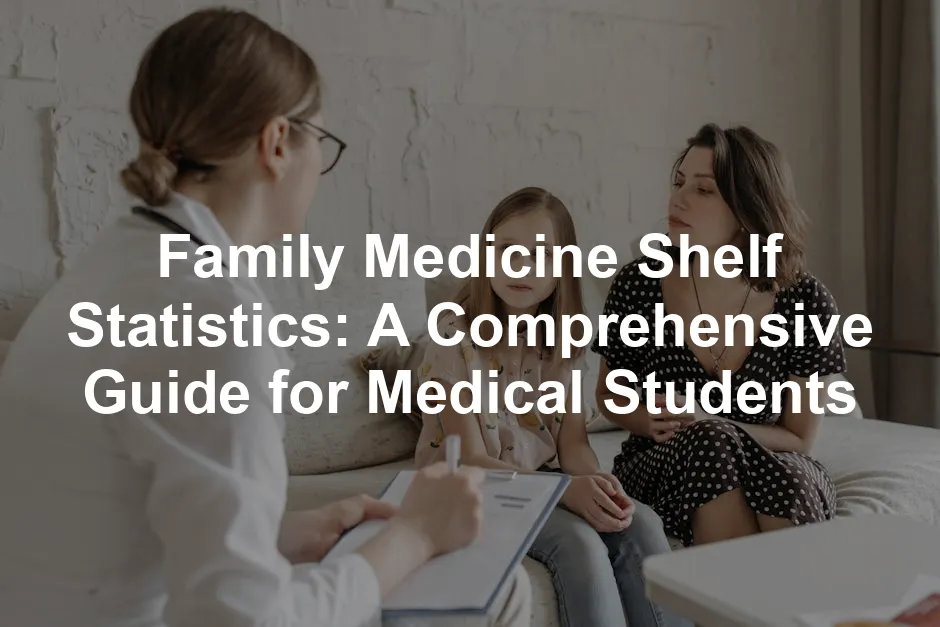Introduction
Family medicine shelf exams are pivotal in shaping a medical student’s education. These exams assess the understanding of essential concepts in family medicine, which is the cornerstone of primary care. They test knowledge from a broad spectrum of topics, including preventive care, chronic disease management, and acute conditions. Performing well on these exams can significantly impact your overall clinical grades and future career opportunities.
Statistics play a vital role in interpreting the results of these exams. Understanding the average scores, pass rates, and percentile data can help students gauge their performance. These statistics also lend insight into where they stand in comparison to their peers. Furthermore, being statistically literate enhances one’s ability to evaluate clinical outcomes and make informed decisions in practice.
This article aims to provide an in-depth look at family medicine shelf statistics. It will explore trends in exam performance, common content areas, and effective study strategies. By arming students with this knowledge, we hope to boost confidence and preparedness as they tackle their family medicine shelf exams. Whether you’re knee-deep in studying or just starting your rotations, this guide is here to support your journey through the world of family medicine.

Understanding Family Medicine Shelf Exams
What Are Shelf Exams?
Shelf exams are standardized assessments administered at the end of clinical rotations, created by the National Board of Medical Examiners (NBME). They serve to evaluate the clinical knowledge and decision-making skills of medical students. These exams are crucial, as they often contribute significantly to final grades in clinical rotations.
Typically, family medicine shelf exams consist of about 110 multiple-choice questions, which students must complete in a limited time—around 2 hours and 45 minutes. The questions can range from direct clinical scenarios to vignettes requiring a deeper understanding of the patient care process. The format is designed to mimic real-world clinical decision-making, challenging students to think critically and apply their knowledge effectively.
The structure of the exam can vary slightly depending on the institution, but students can generally expect a mix of question types. For instance, the questions may include straightforward inquiries about disease management and more complex scenarios involving patient histories. Understanding this format is essential for success, as it helps students prepare effectively and manage their time during the exam.

Content Areas Covered
The family medicine shelf exam follows the guidelines set by the National Board of Medical Examiners (NBME). Understanding the content areas can help students prioritize their studies effectively. Here’s a breakdown of the key content areas:
- Preventive Care (20-25%): This section emphasizes the importance of screenings, immunizations, and health education. Students must grasp the latest guidelines on managing preventive measures. After all, who wouldn’t want to catch diseases before they even start?
- Chronic Disease Management (20-25%): Chronic conditions like diabetes and hypertension are at the forefront here. Students need to be adept at recognizing symptoms, understanding treatment plans, and providing patient education. It’s crucial to know how to manage these conditions effectively, as they are common in family practice.
- Acute Care (30-35%): This area covers the immediate management of acute issues, including injuries and sudden illnesses. It’s a significant chunk of the exam and reflects real-world scenarios that family physicians encounter daily. Get ready to put your knowledge to the test when a patient walks in with a sprained ankle or a severe headache!
- Biostatistics and Epidemiology (1-5%): Though it’s a smaller section, understanding statistics is essential. Students encounter questions related to interpreting data, understanding study designs, and applying statistical concepts in clinical scenarios. It’s like the tiny spice that can make or break a dish—important, but often underestimated.

Exam Difficulty and Student Performance
General Trends
The family medicine shelf exam is known to be challenging, with average scores often hovering around the mid-70s. Pass rates generally range from 75% to 85%. The difficulty lies in the vast breadth of topics covered, making it essential for students to have a solid grasp of family medicine principles and practices.

Student Experiences
Anecdotal evidence from forums and Reddit indicates that many students find the family medicine shelf exam daunting. One student shared that they felt overwhelmed due to the diverse topics and the speed at which questions were presented. Others noted that while they expected a few statistics questions, they were surprised by the number they encountered.
Many students recommend allocating ample time to review preventive care and chronic disease management, as these areas are heavily tested. The consensus is clear: preparation is key. One student humorously remarked, “I thought I could wing it, but it turns out, the exam doesn’t appreciate my improvisation!”
In summary, the family medicine shelf exam presents a mix of clinical challenges and academic rigor. Understanding the content areas and recognizing the exam’s difficulty can empower students to tackle their studies with confidence and clarity.

Percentile Requirements
When it comes to family medicine shelf exams, understanding the percentile requirements can be a game changer. Students often wonder what scores they need to pass or achieve honors. The National Board of Medical Examiners (NBME) sets the bar pretty straightforward.
To pass the family medicine shelf exam, students typically need to achieve a score at or above the 4th percentile. Sounds easy, right? Well, think again! This percentile requirement means that students need to score better than only a small fraction of their peers. In many instances, the average scores hover around the mid-70s. So, doing just enough to pass might not cut it.
If you’re aiming for honors distinction, you’ll want to aim higher. Generally, this means scoring in at least the 90th percentile. That’s the sweet spot that signals exceptional knowledge and understanding of family medicine principles. Achieving this level not only boosts your GPA but also gives you a competitive edge when applying for residency programs.
So, as you prepare, keep these percentile thresholds in mind. It’s not just about passing; it’s about standing out! Focus your studies, practice consistently, and you just might find yourself in that coveted honors bracket. After all, who doesn’t want to be the overachiever in the family?

Common Statistical Questions in Family Medicine Shelf Exams
Types of Statistics Questions
Statistics questions might not be everyone’s cup of tea, but they’re crucial for understanding clinical data. The family medicine shelf exam often tests knowledge on key statistical concepts. Expect to encounter questions on sensitivity, specificity, and predictive values. These terms aren’t just jargon; they are essential for evaluating diagnostic tests and making informed decisions about patient care.
For instance, sensitivity measures how well a test identifies those with a condition. If a test has high sensitivity, it means few false negatives—good news for those anxious about missing a diagnosis! Specificity, on the other hand, assesses the test’s ability to identify those without the condition. A high specificity means fewer false positives, which is vital for avoiding unnecessary treatments.
Additionally, understanding positive and negative predictive values can help you interpret test results accurately. These values tell you the likelihood that a positive or negative test result reflects the actual state of health. Mastery of these concepts can not only aid you in the exam but also help you in real-world clinical scenarios.

Preparation for Statistical Questions
Preparing for statistical questions might feel daunting, but with the right approach, you can conquer them! First and foremost, familiarize yourself with the key concepts mentioned earlier. Use resources tailored for family medicine shelf exams, such as UWorld question bank and AAFP question bank. These platforms provide practice questions that mimic the exam’s format, allowing you to build confidence.
Active learning strategies are your best friends here. Work through practice questions regularly and review explanations for both correct and incorrect answers. This method reinforces your understanding and helps identify any gaps in knowledge. Consider forming study groups where you can discuss statistics concepts and quiz each other.
Another tip? Utilize online resources like Emma Holiday’s Family Medicine Review Guide or OnlineMedEd video series. These platforms break down complex statistical concepts into digestible pieces, making them less intimidating. Remember, regular practice is key. The more you engage with the material, the more comfortable you’ll become with the statistical questions on your shelf exam. So, roll up those sleeves and dive into the numbers—your future self will thank you!

Effective Study Techniques
Creating a Study Schedule
A structured study plan can be your best friend. It helps you balance your time and keep anxiety at bay. Start by identifying your exam date. Then, break down the topics into manageable chunks. Allocate specific times for each subject, ensuring you revisit challenging areas. A well-planned schedule keeps you focused and organized, making study sessions productive instead of stressful. Plus, nothing beats the satisfaction of checking off completed tasks!

Utilizing Question Banks
Question banks are like gold mines for exam preparation. Platforms such as UWorld, AAFP, and BoardVitals offer a treasure trove of questions tailored to the family medicine shelf exam. UWorld is particularly revered for its detailed explanations. This resource helps clarify why an answer is correct or incorrect. AAFP’s question bank is also fantastic for high-yield family medicine questions. BoardVitals rounds out the trio, providing a diverse question set to test your knowledge. Regular practice with these banks can significantly boost your confidence and performance.

Active Learning Strategies
Active learning is a game changer! Engaging with practice questions and case studies makes the material stick. Instead of passively reading, tackle case scenarios that mimic real-life situations. This approach not only helps with retention but also enhances critical thinking. Incorporate spaced repetition techniques as well. Revisit questions you got wrong to reinforce learning. The more you practice, the more prepared you’ll feel walking into that exam room!

Resources for Preparation
Online Resources
When it comes to online resources, the options are plentiful. OnlineMedEd offers concise, high-yield videos on family medicine topics that are incredibly effective for visual learners. Emma Holiday’s videos are another hit, delivering information in a straightforward, engaging manner. Don’t overlook Case Files; they provide real-world cases that deepen your understanding. These resources can help you grasp complex topics and prepare effectively for your shelf exam.

Textbooks and Review Guides
Selecting the right textbooks can make all the difference. Look for high-yield review guides that cover essential family medicine concepts. “Case Files Family Medicine” is a fan favorite, offering case-based learning that prepares you for both the exam and clinical practice. “Step Up to Medicine” is also valuable, particularly for internal medicine concepts that overlap with family medicine. Combine these textbooks with your online resources for a well-rounded study approach.

Common Mistakes to Avoid
Neglecting Practice Questions
One common pitfall is neglecting to practice exam-format questions. Familiarity with the question style can ease exam-day nerves. Many students underestimate the importance of this preparation. Practice questions mimic the actual exam, helping you become comfortable with the format and timing. Make it a routine to tackle practice problems regularly. You’ll find that it not only enhances your knowledge but also boosts your confidence significantly.

Underestimating Preventive Care
Preventive care is a major component of the family medicine shelf exam. Many students mistakenly focus solely on chronic and acute care topics, overlooking this critical area. Ensure your study plan includes preventive measures, screening guidelines, and vaccination schedules. After all, prevention is the best medicine, and understanding these principles can be the key to scoring well on your exam. Prioritize this content to ensure a comprehensive grasp of family medicine.

Underestimating Preventive Care
Preventive care is often overlooked in study plans, yet it plays a crucial role in the family medicine shelf exam. Many students focus intensely on chronic and acute care topics, thinking they are the key to passing. However, neglecting preventive medicine can lead to missed opportunities for scoring well.
Preventive care encompasses health screenings, vaccinations, and education about lifestyle changes. This area accounts for 20-25% of the family medicine shelf exam. These statistics are more than just numbers; they represent critical knowledge that can help save lives. Understanding the latest guidelines from organizations like the USPSTF is vital. After all, who wouldn’t want to catch diseases before they even start?
Integrating preventive care into your study routine ensures a well-rounded preparation strategy. Consider using medical flashcards for Family Medicine to memorize key guidelines or engaging in group discussions to deepen your understanding. The more you emphasize this topic, the better your chances of boosting your exam score. Remember, in family medicine, an ounce of prevention is worth a pound of cure!

Real-Life Experiences and Insights
Student Testimonials
Many students who have recently taken the family medicine shelf exam are eager to share their preparation journeys. One student noted, “I underestimated preventive care topics and ended up regretting it. I wish I had spent more time on those guidelines!” This sentiment echoes through various forums, with students emphasizing the need for a balanced study plan.
Another student highlighted the importance of question banks. “UWorld was my best friend! I practiced daily, focusing on explanations, which helped solidify my understanding,” they said. Engaging with practice questions allowed them to become familiar with the exam format and identify areas needing improvement.
Students also recommend forming study groups. One shared, “We tackled tough topics together and made a quiz game out of it. It made studying fun and less stressful!” Collaborative learning can reinforce knowledge while keeping motivation high.

Expert Advice
Experts in family medicine education emphasize a strategic approach to preparation. Dr. Jane Smith, a seasoned faculty member, advises, “Don’t skimp on preventive care. It’s imperative to understand the guidelines and apply them to clinical scenarios.” Her insights remind students that these principles are not just theoretical; they have real-world implications for patient outcomes.
Additionally, Dr. John Doe, a medical educator, warns against common pitfalls. “Many students fail to practice enough with realistic exam questions. It’s essential to simulate the testing environment,” he says. His advice underscores the significance of timed practice sessions, which can help ease anxiety on exam day.
Incorporating these testimonials and expert insights into your preparation can foster a more comprehensive understanding of the family medicine shelf exam. Learning from peers and faculty can help you avoid common mistakes and enhance your study strategy.

Conclusion
Understanding family medicine shelf statistics is crucial for effective exam preparation. Students must recognize the weight of preventive care and integrate it into their study plans. Balancing chronic and acute care with preventive topics can lead to a more comprehensive understanding of family medicine principles.
As you navigate your preparation, approach it with confidence. Create a study schedule that allows for review of essential topics, including preventive care. Engage with practice questions to familiarize yourself with the exam format. Remember, it’s not just about passing; it’s about excelling.
Take this moment to commit to your studies. Utilize the resources available to you, from question banks to expert advice. The family medicine shelf exam can be a stepping-stone to your future career. Embrace the challenge and aim for success!

Frequently Asked Questions (FAQs)
What is the typical format of the family medicine shelf exam?
The family medicine shelf exam typically consists of 110 multiple-choice questions. Students have approximately 2 hours and 45 minutes to complete the exam. Each question is designed to test clinical knowledge and decision-making skills across various family medicine topics. Time management is crucial, as students must balance accuracy with speed during the exam.
Understanding statistical questions in exams is crucial for success. Check out this resource on statistical questions in basketball for a deeper insight.
Please let us know what you think about our content by leaving a comment down below!
Thank you for reading till here 🙂
All images from Pexels




